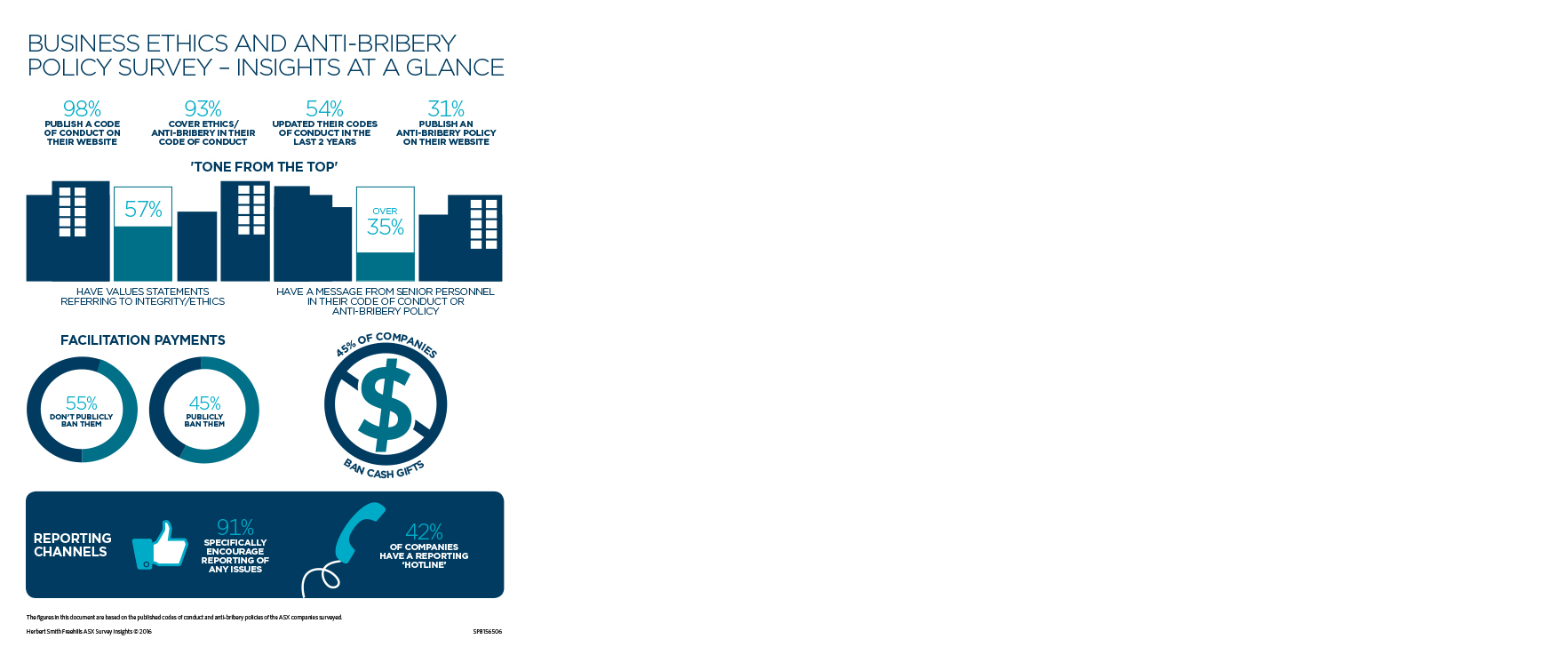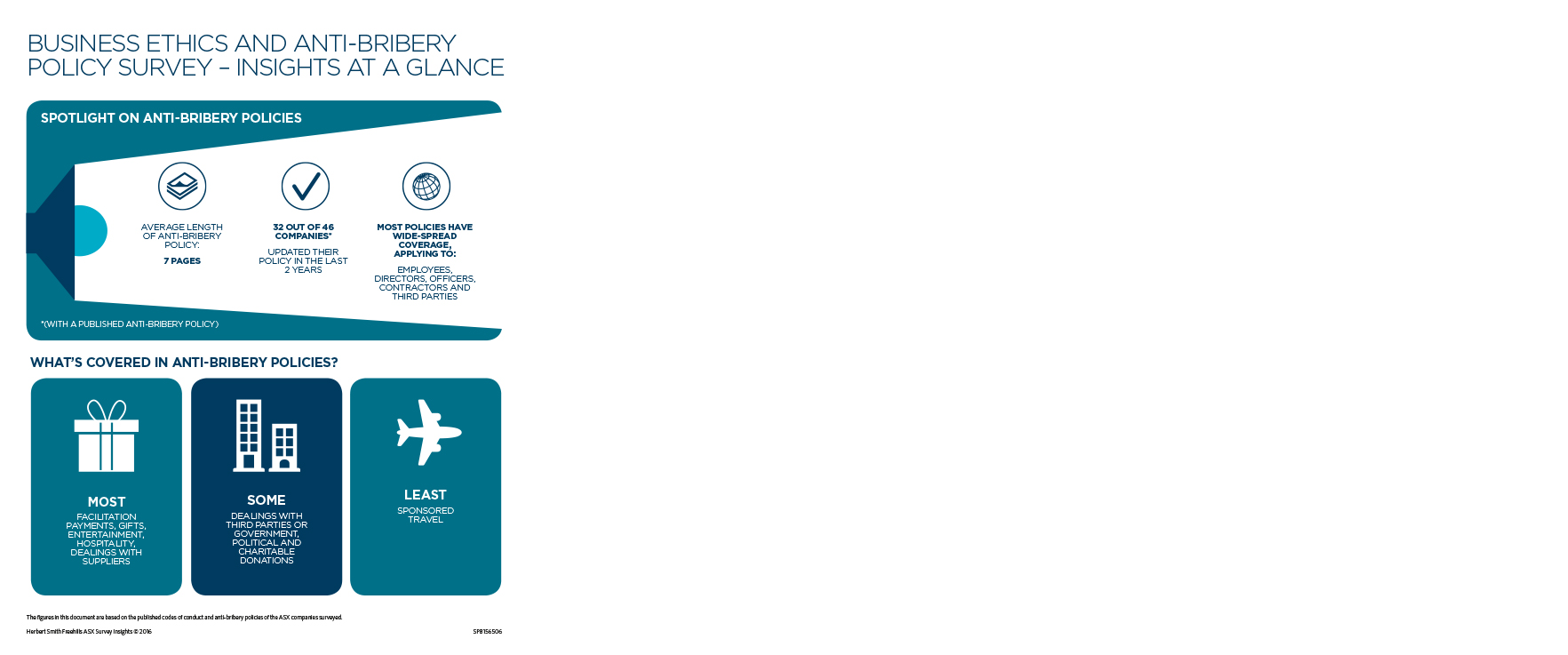Our survey of the Top 150 ASX companies provides an insight into corporate Australia’s approach to business ethics, codes of conduct and anti-bribery policies. How does your company compare?
Codes of conduct and anti-bribery policies set the framework for a company’s approach to anti-corruption compliance. Although only one component of an effective compliance system, they outline expectations, and provide a baseline to guide employees through what can be complex issues to address in practice.
In this report, we outline the findings of our survey of the published codes of conduct and anti-bribery policies of the ASX Top 150 companies.
- Key findings
- ASX Survey Insights
- Spotlight on Anti-Bribery Policies
- How anti-bribery policies are evolving
Key Findings
A commitment to integrity in business dealings is strongly reflected among Australia’s Top 150 ASX companies.
- The overwhelming majority of companies publish a code of conduct on their website.
- In almost all cases the code of conduct addresses either ethics or integrity generally or anti-bribery and corruption specifically.
- Over half of the companies surveyed have corporate values or mission statements that reinforce the importance of ethics and integrity.
- Over 35% of companies show ‘tone from the top’ by embedding an explicit statement of support from senior personnel (the Chairman, CEO or other senior executives) in their codes of conduct or anti-bribery policy.
Companies are keeping their codes of conduct and anti-bribery policies refreshed.
- Almost half of the companies surveyed updated their codes of conduct in the last 2 years.
- Almost all of the published anti-bribery policies have been published or updated since 2013.
The codes of conduct and policies surveyed varied in the extent to which they specifically addressed key areas of bribery and corruption risk.
- Gifts was the risk area most commonly addressed in both codes of conduct and anti-bribery policies, followed by entertainment/hospitality. Other areas of risk had more mixed coverage.
- Over 60% of companies surveyed have a code of conduct which addresses dealing with suppliers, while around 42% have a code which mentions dealing with governments, or government officials.
- Over one third of the companies did not have a code of conduct or anti-bribery policy which mentions dealing with third parties and business partners, one of the primary areas where bribery and corruption risks commonly arise for corporates.
- Other areas typically less commonly addressed included charitable donations and sponsorships, and political donations.
- Risks associated with sponsored travel was the area least addressed in both codes of conduct and anti-bribery policies.
- Published anti-bribery policies covered a greater proportion of key risk areas than codes of conduct, as would be expected.
Approaches to facilitation payments and cash gifts also differ.
- 45% of companies prohibit facilitation payments in their published code or anti-bribery policy.
- 45% prohibit cash gifts.
- That means that a large portion of the surveyed companies do not, based on their published policies, prohibit such payments.
Most companies specifically encourage reporting of any issues and employees are generally encouraged to report issues up to their manager or supervisor. Over 40% of companies refer employees to a reporting ‘hotline’.
Only 31% of companies publish an anti-bribery policy on their website. This is consistent with the approach we saw more generally, with some companies choosing to publish comprehensive policies on their websites on topics such as anti-bribery/corruption, whistle-blowing and dealings with suppliers. Others do not publish these types of policies at all.
Anti-bribery policies vary in the extent to which they are embedded within a suite of other supporting policy documents. Over a third of the policies we looked at approach anti-bribery and corruption compliance by incorporating and referring staff to a range of supporting policy documents dealing with specific related topics. The remainder publish a more detailed standalone anti-bribery policy, which may refer to one other policy only, typically a whistleblower or disclosure policy.
ASX Survey Insights

Spotlight on Anti-Bribery Policies

How anti-bribery policies are evolving
Read how anti-bribery policies are evolving in our comparative review of policies which had been published in 2012/2013 (being the dates of the earliest publically available policies), with those published recently this year and late 2015.
To request a copy of our findings, or more information about our industry specific findings, please contact Grant Marjoribanks or Jacqueline Wootton.
The survey was completed with the assistance of Anita Thompson, Chloe Smith, Tehanee Bardolia, Laura Baykara, Stephen Somerville, Mark Tyndall, Ada Vuu and Katya Udorovic.
Key contacts
Legal Notice
The contents of this publication are for reference purposes only and may not be current as at the date of accessing this publication. They do not constitute legal advice and should not be relied upon as such. Specific legal advice about your specific circumstances should always be sought separately before taking any action based on this publication.
© Herbert Smith Freehills 2024




